Granted, it was prohibitively expensive for most of the world with a pre-sale estimate of $550,000 – 750,000, but it’s so rare and so wonderful that I expected Tiffany Studios’ Bat Table Lamp to be snapped up right quick by one the many deep-pocketed buyers that frequent Sotheby’s auctions. They were certainly on hand, since someone shelled out $1,565,000 for the iconic Wisteria Table Lamp which was estimated to sell in the same range ($600,000 — 800,000) as the Bat.
No disrespect to the Wisteria, but nobody puts the Bat Table Lamp in a corner. Behold its genius:
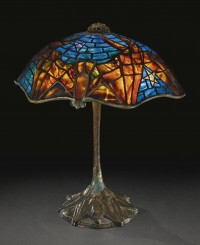
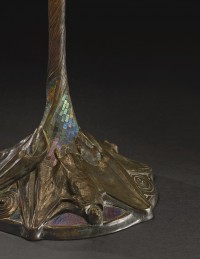
The Bat lamp, like its cousin the Dragonfly Table Lamp, was a departure from the floral patterns that had dominated the glassworks since its inception in 1893. Louis Comfort Tiffany was inspired to start the Queens factory after being “overwhelmed” by Emile Gallé’s pioneering Art Nouveau glass at the 1889 Paris Exposition. Gallé, who would make several wonderful bat-themed pieces including a lamp that pre-dates Tiffany’s, focused on natural motifs with an emphasis on flowerforms and so did Louis’ new glass company.
It was the influence of Japanese and Chinese art that brought the bat into the picture. Instead of being symbols of death and night, the Bram Stoker bat, if you will, in Asian art bats represent long life and good fortune. Japonisme, as the trend was called in France, inspired Art Nouveau designers from architecture to jewelry to wallpaper, and bats started to crop up more and more the last decade of the 19th and first decade of the 20th century.
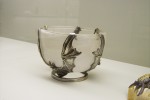
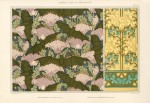
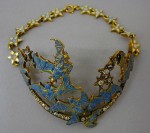
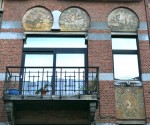
Tiffany Studios’ introduction of a “Bat” lamp after 1902 is timely within this historical context. Although still unusual, the bat motif had gained prominence and was stylish. Moreover, its use on lamps was particularly appropriate since, after all, lamps are used at night, the temporal realm of bats. The decoration expresses the object’s function, but in a poetic and charming way.
 Tiffany first explored the bat in a vase that he exhibited at the 1893 World’s Columbian Exposition in Chicago. Like he would later with the Bat Table Lamp, he set the flying mammals against a starry night sky. When he took the theme to leaded glass, the background became darker, a rich midnight sky with blue and yellow stars against which the contrasting oranges and browns of the articulated bats glow.
Tiffany first explored the bat in a vase that he exhibited at the 1893 World’s Columbian Exposition in Chicago. Like he would later with the Bat Table Lamp, he set the flying mammals against a starry night sky. When he took the theme to leaded glass, the background became darker, a rich midnight sky with blue and yellow stars against which the contrasting oranges and browns of the articulated bats glow.
 Created around 1905, on the Tiffany Studios 1906 Price List the Bat lamp was priced at $125. In a time when the average wage was 22 cents an hour, this was a high luxury item. The glass mosaic inlay you can see above the bats on the base was particularly costly and time-consuming to produce. Just to give you some comparisons, the Wisteria lamp, made out of 2,000 pieces of individually cut glass, was listed on the 1906 Price List at $400. The Cobweb Table Lamp was even more expensive, listed in 1906 for $500. One example sold at auction last year for $3,250,000. They were all three popular in their day — Wisteria most of all — but today there are only seven known Cobwebs extant and five Bats.
Created around 1905, on the Tiffany Studios 1906 Price List the Bat lamp was priced at $125. In a time when the average wage was 22 cents an hour, this was a high luxury item. The glass mosaic inlay you can see above the bats on the base was particularly costly and time-consuming to produce. Just to give you some comparisons, the Wisteria lamp, made out of 2,000 pieces of individually cut glass, was listed on the 1906 Price List at $400. The Cobweb Table Lamp was even more expensive, listed in 1906 for $500. One example sold at auction last year for $3,250,000. They were all three popular in their day — Wisteria most of all — but today there are only seven known Cobwebs extant and five Bats.
The Bat Table Lamp was discontinued in 1910 when Tiffany Studios stopped producing mosaic inlay models because of how expensive and labor-intensive they were to make.